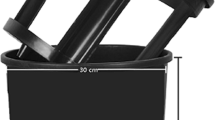Abstract
Changes in ascorbic acid levels were followed in apical and basal portions of Russet Burbank and Kennebec tubers during growth and development. Influence of nitrogen fertilization during growth and short-term storage on ascorbic acid level of the tuber was also studied. Changes in ascorbic acid content during growth showed two distinct phases, the first phase being characterized by an increase in ascorbic acid content with growth and development of the tuber, followed by a second phase which showed a decrease in ascorbic acid content with increasing maturity. The shift from the first phase to the second phase occurred earlier for Kennebec than for Russet Burbank. Increased nitrogen fertilization resulted in a delay of this shift from the first to the second phase. The apical portion of the tuber consistently showed higher ascorbic acid content than the basal portion. Kennebec tubers were higher in vitamin C content than tubers of Russet Burbank cultivar. High nitrogen fertilization resulted in less ascorbic acid content during growth. Storage of tubers for four weeks at 5.5°C also resulted in a marked decrease in ascorbic acid content of tubers. Nitrogen fertilizer rate during growth had no influence on the decrease in ascorbic acid content of tubers in storage.
Resumen
Cambios en los contenidos de los niveles de ácido ascórbico fueron evaluados en la zona del estolón y de los brotes de tubérculos de Russet Burbank y Kennebec durante el crecimiento y desarrollo. La influencia de la fertilizatión con nitrógeno durante el crecimiento y corto almacenaje de los niveles de ácido ascórbico en los tubérculos fueron también estudiados. El contenido de ácido ascórbico durante el crecimiento mostró dos fases distintas; la primera fase se caracterizó por un aumento en el contenido de ácido ascórbico con un incremento del crecimiento y desarrollo de los tubérculos seguido por una segunda fase que mostró una reducción en el ácido ascórbico mientras aumentaba la madurez. El cambio de la primera fase a la segunda fase ocurrió más temprano en la variedad Kennebec que en la variedad Russet Burbank. El aumento de la fertilización nitrogenada provocó un retraso en el cambio de la primera a la segunda fase. La región de los brotes en los tubérculos mostró consistemente mayor contenido de ácido ascórbico que en la porción basai. Los tubérculos de Kennebec tuvieron más alto contenido de vitamina C que los tubérculos de Russet Burbank. La alta fertilización nitrogenada provocó una reducción en el contenido de ácido ascórbico durante el crecimiento. Los tubérculos almacenados por 4 semanas a 5.5°C manifestaron una marcada reducción en el contenido de ácido ascórbico. La dosis de fertilización nitrogenada no tuvo influencia en la reducción del contenido de ácido ascórbico de los tubérculos del almacenaje.
Similar content being viewed by others
Literature Cited
AOAC. 1970. Official methods of analysis, 11th ed. Association of Official Analytical Chemists, Washington, D.C., p. 777.
Abramova, L.S. 1961. Content of Vitamin C and B in certain crops of the Irkutsk region. Lekarstv Syr’evye Resurisy Irkutskoi Obl, Irkustk Sb, No. 3, pp. 3–7.
Aslanyan, S.A. 1962. Effects of various mineral fertilizers on the content of Vitamin C in potatoes. Vestn Sel’skokhoz Nauki, Vser,Akad Sel’skokhoz Nauk 7, No. 1, pp. 21–24.
Augustin, J., R.E. McDole, G.M. McMaster, C.G. Painter and W.C. Sparks. 1975. Ascorbic acid content in Russet Burbank potatoes. J Food Sci 40:415–416.
Biletska, L.K. 1961. Dynamics of ascorbic acid and starch in tubers during preservation of potatoes. Visn, Silsko gospodar Nauki 4, No. 6, pp. 108–111.
Bring, S.V. 1966. Total ascorbic acid of shoestring potatoes. J Am Diet Assoc 48:112–115.
Bring, S.V. and F.P. Raab. 1964. Total ascorbic acid in potatoes. Raw, fresh, mashed and reconstituted granules. J Am Diet Assoc 45:149–152.
Charlampowicz, A. and H. Sowinska. 1965. Distribution of L-ascorbic acid in potato tissues. Zeszyty Probl Postepow Nauk Rolniczych 5:123–127.
Enachescu, G. 1960. Variation in ascorbic acid and thiamine content of potatoes during storage. Acad Rep Populare Romine Studii Cercetari Biol, Ser, Biol. Veg. 12:239–258.
Gander, J.E. 1976. Monoand oligosaccharides.In: Plant Biochemistry, 3rd ed., eds. Bonner, J. and J.E. Varner. Acad Press, New York, pp. 358–359.
Gebauer, H. 1958. Vitamins and plants. Qualitas plant et materiae vegetabiles, pp. 3–4, 161–165.
Iritani, W.M. and L. Weiler. 1972. Influence of growing conditions on storage and process ability of Russet Burbank potatoes. Proc. of 11th Annual Wash. State Potato Conf., Moses Lake, WA, Feb.
Namek, M. and E. Moustafa. 1953. Factors affecting ascorbic acid and carbohydrate contents in potatoes in Egypt. Fac Agric Cairo Univ Bull 38.
Ruchkin, V. N. and O.N. Zotova. 1961. Content of carotene in yellow potato varieties in Omisk Region. Biokhim Plodov i ovoshchei, Akad Nauk SSSR, Inst Biokhim, No. 6, pp. 122–131.
Smith, O. 1968. Potatoes: Production, storing and processing. The Avi Publishing Co., West Port, CT. 90 p.
Sweeny, J.P., P.A. Hepner, and S.Y. Liebeck. 1969. Organic acid, amino acid and ascorbic acid content of potatoes as affected by storage condition. Am Potato J 46:463–469.
Trautner, K. and J. C. Somogyi. 1964. Biosynthesis of Vitamin C inpotato slices. Intern Z Vitamin Forsch 34:433–435.
Volkov, V.D. 1959. Biochemical features of early ripening potato tubers. Vest Sel’skokhoz Nauki 4, No. l,pp. 141–144.
Yamaguchi, M.G., J. Perdue, and J. MacGillivray. 1960. Nutrient composition of White Rose potatoes during growth and after storage. Am Potato J 37:73–76.
Author information
Authors and Affiliations
Additional information
Scientific Paper No. 4923. Project No. 1949. College of Agriculture Research Center, Washington State University, Pullman, Washington 99164. Financed in part by Washington State Potato Commission.
Former Research Assistant.
Rights and permissions
About this article
Cite this article
Shekhar, V.C., Iritani, W.M. & Arteca, R. Changes in ascorbic acid content during growth and short-term storage of potato tubers (Solanum tuberosum L.). American Potato Journal 55, 663–670 (1978). https://doi.org/10.1007/BF02852139
Received:
Issue Date:
DOI: https://doi.org/10.1007/BF02852139



